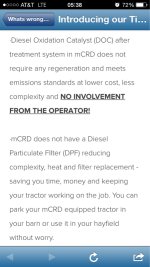DavesTractor
Elite Member
Can't comply.
I am using Tier 4B and as you know the exhaust comes out cleaner than the intake air!
Everything I read on the Internet is true......
In Utopia it is anyway....
Can't comply.
I am using Tier 4B and as you know the exhaust comes out cleaner than the intake air!
Everything I read on the Internet is true......
Dave1949 You are correct, the EPA won't come out and say it. They just will not enforce it, which for the EPA is like saying they messed up. And you might ask, "how did they mess-up"? They pushed the standards onto the engine manufacturers before they had the technology. And i don't believe it would be politically palatable to go back and enforce it. Best example i can come up with is the AIR pumps everybody took off in the late 70s early 80s. Compared to the catalytic converters which have to be left on. I think they will just ignore it and move on. Some states might go after it, but it will be expensive proposition, the only way they could find it is they would have to smog test for it. And on top of all this the EPA has to be smart enough to figure it is going on as large scale as it it. They are just not going to stick it to the little guy and tell him he has to spend that money to put it back on, it will put to many trucking companies out of business. the EPA will mess with one or two little guys, not a large group like this and they'll mess with the deep pockets i don't think they would mess with what would turn out to be a large issue. Might try, just don't think it would turn into anything. Individuals vote companies don't.

The Mahindra design of engines has a DOC Diesel Oxidation Catalyst. Instead of the DPF in the exhaust. Only time will tell how reliable this system is. It appears to work like a Catalytic Converter for gasoline engines. The DOC appears to cost less to replace if it did break. Some people act like Mahindra designed an engine that has no exhaust after treatment. That is not true.
The only thing you get wrong is; no one is getting sick or cancer from diesel particles. HSI've read all of the comments in this thread and it is a good discussion. If I were to summarize I would make these points. Nano Particles make dust particles seem like boulders - Thanks Dave1949 The compounds attached to these particles cause cancer, period. Scientific evidence has proven this; it is fact. Various methods of reducing or eliminating diesel soot are being employed. Some may be better than others but at the end of the process, clean diesel engines will be the result. Cost to the equipment user is appropriate. There is cost regardless but asking your neighbor to pay the price instead of you, the owner operator of the engine, is just not right. For those that just reject science, I have nothing to say. I suppose some folk continue to believe the earth is flat. We are not going to see a reversal of the requirement to control diesel soot for the same reason we will never see the requirement to wear a seatbelt reversed. For anyone that finds himself with a poorly designed or short lived system to reduce soot, raise **** with the dealer/manufacturer. The systems should be cost effective, robust and transparent to the operator.
I think you're slightly off. I think everyone has read the same information as you. I don't get where "some people" are acting like Mahindra doesn't use any treatment to the exhaust (got a source?). I think the preference some show toward the Mahindra system has to do with part of what you mentioned which is the apparent cost difference. Hearing about the few DPFs that've had to be replaced at $3k each (even though most or all have been warranty items thus far) should be enough to make anyone cringe at the thought of owning one. I think the other thing that folk like about the Mahindra system is there is no regeneration cycles needed to clean it back up every few hours. I've personally came across nobody that thinks the Mahindra engines are just magically cleaner.
What I didn't post is that engines that have just a DOC do not remove as much particulate matter as a DPF system does.